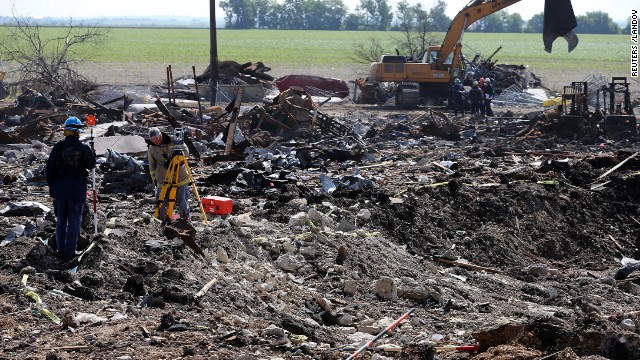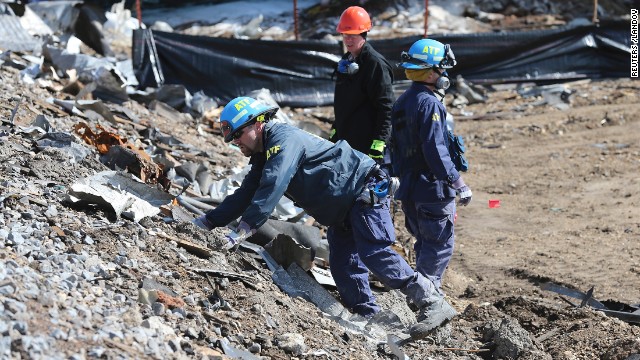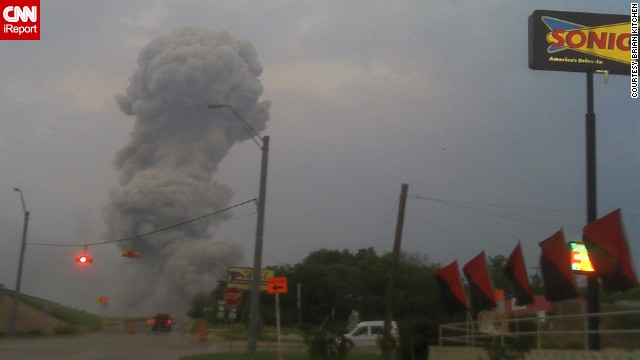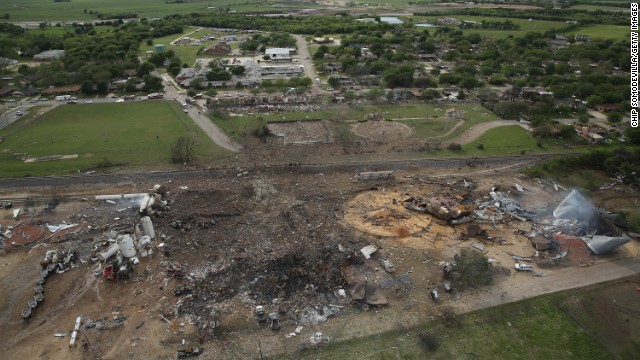The fertilizer plant that
blew up in Texas last week warned state and local officials but not federal
agencies that it had 270 tons of highly volatile ammonium nitrate on site,
according to regulatory records.

The April 17 fire and
explosion at West Fertilizer Co. killed 14 people and devastated the small town of West, Texas.
Investigators have said they're not sure how much ammonium nitrate was actually
on site at the time of the explosion, however, since plant records were
destroyed in the blast.

Obama tells victims' families that nation will help
them recover
The company sold ammonium
nitrate and anhydrous ammonia, both commonly used as fertilizers.
It had notified state and
local emergency management officials of its stock of both in its most recent
declaration of hazardous chemicals, filed in February.
However, the risk
management plan it filed with the federal Environmental Protection Agency in
2011 mentioned only anhydrous ammonia, which produces suffocating fumes and can
cause burns if mishandled. The plan listed as a worst-case scenario "the
release of the total contents of a storage tank released as a gas over 10
minutes" and did not warn of the risks of explosion.
Federal law requires
any operation that holds more than a ton of fertilizer-grade ammonium nitrate
to report that stock to the Department of Homeland Security. Proposed new rules
would cut that to 25 pounds. But Homeland Security Secretary Janet Napolitano
told a Senate subcommittee Tuesday that West Fertilizer doesn't appear to have
reported its ammonium nitrate stock to federal officials, adding, "We're
following up on that."
In a statement issued
earlier this week, after the first lawsuit against it was filed in connection
with the explosion, the company said its focus "remains on the fact
finding."
"We continue to do
everything we can to understand what happened to ensure nothing like this ever
happens again in any community," it said. "To that end, the owners
and staff of West Fertilizer Co. are working closely with investigating
agencies. We have encouraged all employees to assist in the fact finding to
whatever degree possible."
Among the dead was plant
foreman Cody Dragoo, who was also a member of the town's volunteer fire
department.The explosion happened
about 20 minutes after the first report of a fire there. It registered on
seismographs as a magnitude 2.1 earthquake and could be felt 50 miles away.
Town devastated by fertilizer explosion is guided by
the West way
Last week's explosion
damaged numerous houses, a nursing home and the town's high school and middle
school, all of which were built within a few hundred feet of the plant. That's
raised concern about similar facilities in other towns, both in rural
communities like West and major cities like Houston, the heart of the oil
industry.
Animals become symbols of hope in Texas town
"I know there's
hundreds of public schools on the fenceline or very close to these industrial
plants," said Neil Carman, a former Texas Department of Environmental
Quality inspector now working for the state Sierra Club. "I wouldn't be
surprised if it's over 1,000."
Zoning restrictions are
rare in the state, and Carman said there have been thousands of complaints from
neighborhoods in areas like Houston, Beaumont and Corpus Christi, home to
numerous oil refineries.
West Fertilizer had been
twice cited by federal regulators twice since 2006.
In 2012, the Transportation
Department's Pipeline and Hazardous Materials Safety Administration fined West
Fertilizer $5,250 for storing anhydrous ammonia in tanks that lacked the proper
warning labels. The agency originally recommended a $10,000 penalty, but it was
reduced after the company took corrective action.
In 2006, the EPA fined it
$2,300 owners to correct problems that included a failure to file a risk
management program plan on time. The TCEQ also investigated a complaint about
the lingering smell of ammonia around the plant the same year.













